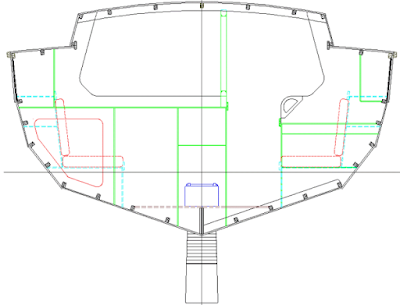Jacobs Brothers in Cape Town, South Africa, are building a Dix 43 Pilot for a local customer, who is having to halt the project for financial reasons. This is a well-proven cruising design, with a record of multiple passages to both the Arctic and Antarctic in addition to more normal cruising grounds.
All metalwork has been completed to a very high standard by these expert builders. Only winch pads, sheet car
tracks and through hull spigots remain to do of the hot work but those are included in the price required by the seller.
 |
| Dix 43 Pilot in Jacobs brothers Workshop |
 |
| Pilothouse & dodger details. |
 |
| Cockpit & stern details. |
 |
| Bow details. |
 |
| Steering gear installation. |
 |
| Engine on beds. |
If interested in taking over this project, please contact me by email and I will put you in contact with the seller to discuss with him.
The following is directly from the seller, describing the state of the project and what additional items are included.
The ideal scenario is that someone takeover and
complete with the Jacobs. They are ready and willing to crack on asap.
The lead is in, sealed and pressure tested as
are the water and diesel tanks. The new Yanmar 57hp engine is also in the boat
along with stern tube and P bracket.
These are the engine specs.
1X 4JH57 ENGINE
1X KM35P 2.36 GEARBOX
1x ENGINE MONITORING SYSTEM
1X U-TYPE MIXING ELBOW
1X HOT WATER KIT 1X SECOND ALTERNATOR
125AMP
1X 10M EXTENSION HARNESS
1X YD42 X A15 PANEL
The spade rudder is installed with Jefa bearings
as is the Jefa Type 2 rotary autopilot.
I have bought the following steering gear
which is included.
Jefa Pedestal, fiberglass three spoke wheel and
rod/pinion linkage.
These are the Jefa equipment specs:
RP150 Pedestal, rack and pinion, height 710mm
with guardrail and binnacle.
Pedestal HEAD150-3-R9010 GRP head for RP150
pedestal.
EC150 Engine control.
Compass, Plastimo Olympic 135 with Black
card.
Draglink 700 to 800mm centres.
TLJ100 Tiller lever L=250 mm c/c , max.Ø100 mm
incl. bore and keyway TLJLEVER Extra lever for autopilot .
TLJPIN16 Pin for 16mm Draglink / lever 2 Pcs
DU-DD2-12 Direct Drive 375Kgm 12V with extended
output lever 130-165-200mm DU-TS-RFB2 Rudder feed-back integrated for
Raymarine.
DL040050-25 Draglink 400 to 500mm centres.
WHCG1000B Fiberglass wheel 1000mm black.
Brake spinner 120mm for GRP wheel.
I have also bought the following material that
will be included.
SPX33 60mm insulation.
Aerozip hot water pipe insulation
Soundseal sound proofing
Mascoat DTM insulation paint
Marine plywood
The sugar scoop has been extended as per the
cutting files from Robert Christinger and we added a radar arch with davits, a
bowsprit anchor roller for a Rocna 33. Anchor included.
Email Dudley Dix
Dudley Dix Yacht Design main website
Dudley Dix Yacht Design mobile website
















